| Doru | |
|---|---|
 | |
| Doru taeniatum | |
| Scientific classification | |
| Domain: | Eukaryota |
| Kingdom: | Animalia |
| Phylum: | Arthropoda |
| Class: | Insecta |
| Order: | Dermaptera |
| Family: | Forficulidae |
| Genus: | Doru |
| Species | |
See text | |
Doru is a genus of earwigs in the family Forficulidae. [1]
| Doru | |
|---|---|
 | |
| Doru taeniatum | |
| Scientific classification | |
| Domain: | Eukaryota |
| Kingdom: | Animalia |
| Phylum: | Arthropoda |
| Class: | Insecta |
| Order: | Dermaptera |
| Family: | Forficulidae |
| Genus: | Doru |
| Species | |
See text | |
Doru is a genus of earwigs in the family Forficulidae. [1]
Doru can be recognised by having yellow elytra with a black suture. [2]
According to the original description by Malcom Burr, the third and fourth antennal segments are subequal. The elytra are not carinate. The abdomen is subparallel and depressed in shape. The anal segment of the abdomen is transverse, depressed and not sloping. The pygidium is spinous or sharp. In males, the arms of the forceps are slender, removed from the base and not expanded. [3]
In North America, these earwigs can be found on grasses and sedges, usually near water. [2]
These 16 species belong to the genus Doru:
Data sources: i = ITIS, [4] c = Catalogue of Life, [5] g = GBIF, [6] b = Bugguide.net [7]

Earwigs make up the insect order Dermaptera. With about 2,000 species in 12 families, they are one of the smaller insect orders. Earwigs have characteristic cerci, a pair of forcep-like pincers on their abdomen, and membranous wings folded underneath short, rarely used forewings, hence the scientific order name, "skin wings". Some groups are tiny parasites on mammals and lack the typical pincers. Earwigs are found on all continents except Antarctica.

Forficula auricularia, the common earwig or European earwig, is an omnivorous insect in the family Forficulidae. The European earwig survives in a variety of environments and is a common household insect in North America. The name earwig comes from the appearance of the hindwings, which are unique and distinctive among insects, and resemble a human ear when unfolded; the species name of the common earwig, auricularia, is a specific reference to this feature. They are considered a household pest because of their tendency to invade crevices in homes and consume pantry foods, and may act either as a pest or as a beneficial species depending on the circumstances.

Forficulidae is a family of earwigs in the order Dermaptera. There are more than 70 genera and 490 described species in Forficulidae.
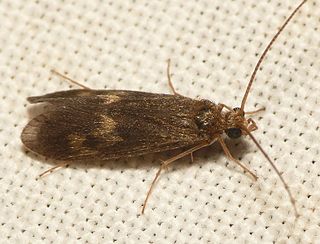
The Polycentropodidae are a family of trumpet-net and tube-making caddisflies. There are at least 30 genera and 720 described species in Polycentropodidae. The type genus for Polycentropodidae is Polycentropus J. Curtis, 1835.

Aglaothorax is a genus of ovate shieldbacks in the family Tettigoniidae. There are about six described species in Aglaothorax.

Neduba is a genus of insects in the family Tettigoniidae (katydids), which is native to North America.
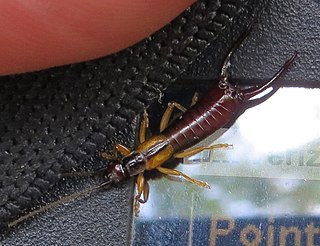
Doru aculeatum, the spine-tailed earwig, is an insect in the family Forficulidae. This earwig is found in the woods and grassy areas of eastern North America and occurs at outdoor lights at night.
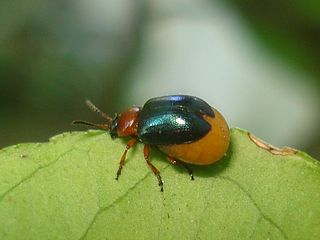
Gastrophysa is a genus of beetles in the family Chrysomelidae, in which the females typically exhibit swollen, membranous abdomens, a condition known as physogastrism.

Melanoplini is a tribe of spur-throated grasshoppers in the family Acrididae. There are about 19 genera and more than 200 described species in Melanoplini, all in North America. Their biogeography shows that many species in the tribe have descendants from the Eocene epoch and Miocene epoch.

Aeoloplides is a genus of spur-throated grasshoppers in the family Acrididae. There are about nine described species in Aeoloplides.

Doru taeniatum, the lined earwig, is a species of earwig in the family Forficulidae. It is found in Central America, North America, and South America.
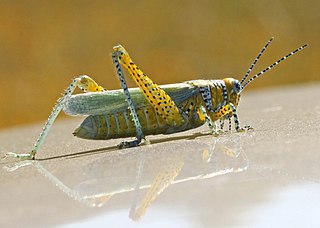
Poecilotettix is a genus of spur-throated grasshoppers in the family Acrididae and the tribe Dactylotini. There two known described species in Poecilotettix.

Marava is a genus of little earwigs in the family Spongiphoridae; most records are from the Americas, but M. arachidis is cosmopolitan. There are more than 50 described species in Marava.
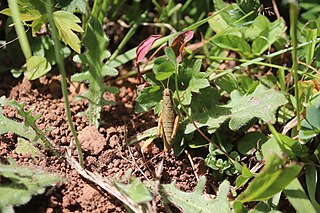
Booneacris is a genus of spur-throated grasshoppers in the family Acrididae. There are at least four described species in Booneacris.
Janus is a genus of stem sawflies in the family Cephidae. There are about five described species in Janus.

Campylacantha is a genus of spur-throated grasshoppers in the family Acrididae. There are about five described species in Campylacantha.

Aptenopedes is a genus of spur-throated grasshoppers in the family Acrididae. There are about 13 described species in Aptenopedes.

Guanchia is a genus of earwigs in the family Forficulidae. There are more than 30 described species in Guanchia.
Diplatys is a genus of Asian earwigs, in the family Diplatyidae, erected by Jean Guillaume Audinet-Serville in 1831. The recorded distribution of species is from Indochina, although this may be incomplete; it is also worth noting that other genera in subfamily Diplatyinae and the genus Haplodiplatys historically have been placed here.
Liparura is a genus of earwigs within the family Forficulidae.